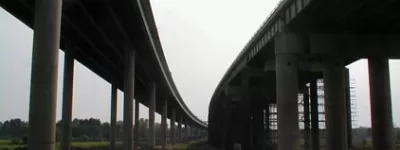The M90 connects Edinburgh, via the Queensferry Crossing, to Perth, leading on to the A9 to the north and A90 to the north-east of Scotland.
When the motorway first opened in 1964, it formed the northern approach to the Forth Road Bridge, which was part of the A90 and not a motorway. It remained an entirely isolated outpost of the motorway network until 2017 when the new Queensferry Crossing carried it over the Forth. A short section between junctions 1 and 1A remains part of the A90, so technically the majority of the route remains isolated from the national motorway network, but a short length of M90 does meet the M9.
South of the Forth, the route followed by the M90 is decidedly circuitous, a product of the history of the major roads west of Edinburgh. Its southernmost section, from the M9 to junction 1, was originally built as a short spur from the M9 to the original Forth Road Bridge, completed in 2007. To reduce the costs and the environmental impact of the new bridge, it was decided not to build a direct approach from the M9 but instead to plug the new bridge into the old approach roads. This means that the M90 performs a number of contortions between the M9 and the Queensferry Crossing that make a map of the route look like some sinuous mountain pass, which are entirely unnecessary in terms of the surrounding geography and are only there because of the piecemeal development of the road.
Further north, as the motorway reaches some genuinely challenging terrain north of Kinross, it begins to twist and turn again. It has some notably sharp corners (including what is reputedly the tightest curve on any rural motorway mainline in the UK), and parts of it lack hard shoulders, instead just having frequent lay-bys. At one time, rural Scottish motorways with predicted traffic levels below a certain level were built this way, but most have now had hard shoulders retrofitted and this is the only remaining length of rural motorway in the UK with just two lanes and no hard shoulder.
Ronnie Land, who worked on the scheme in the 1960s, notes that the three-way motorway interchange south of Perth was a major feat, requiring the removal of some 900,000 cubic metres (31,783,000 cubic feet) of material. The minimum curve radius used on the route is 694m (2,278ft), far below the minimum of 914m (3,000ft) that was standard practice at the time. Likewise the maximum gradient then permitted by design standards was 1 in 30 (1 in 20 for hilly areas), but some of the M90's slip roads are a little steeper than 1 in 17.
In the early 1990s, mass renumbering of roads up the east side of Scotland was carried out to give the route from Edinburgh to Aberdeen one continuous number, A90. This did some strange things to the area south of Perth. At the northern end of its route, approaching Perth, the motorway splits into two branches. Before the change, the M90 went up the west branch to meet the A9. The A85 ran east from Perth to Dundee, and so the branch to the east of Perth, over the Friarton Bridge, was M85.
The renumbering replaced the A85 with the A90, and the M90 designation was applied to the branch east of Perth in order to connect the motorway to the extended A-road. The M85 ceased to exist, but the western branch - which meets the A9 - is also still technically the M90. It's signposted "(A9)" northbound to avoid confusion. The western branch is longer than the east, and travels further north; while it appears to be a spur of the motorway, though, Broxden Roundabout at its northern end is now junction 12, which suggests that both branches may have equal status.

